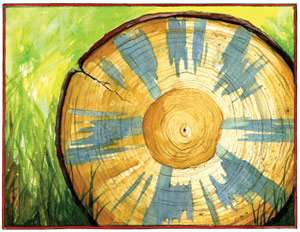
Most loggers are well aware of the perils of blue stain. If freshly cut logs are left for any length of time in the summer months, one of the many species of fungus that leave bluish streaks in the wood is sure to invade the logs, dramatically reducing their value.
White pine and sugar maple are among the most vulnerable to blue stain – also called sap stain because it only affects sapwood. These species are best harvested from November to May, when it’s cold enough in these parts that sap-staining fungi are pretty much incapacitated.
Several of the most common staining fungus species are in the genus Ophiostoma, but fungi from several other genera also leave dark stains in the wood they infect. The members of this informal group are not able to decompose cellulose or lignin like most of the decay organisms we are familiar with. Instead, they feed on sugars, proteins, starches, and fats that are stored in bark and sapwood. For reasons that are not entirely clear, these fungi synthesize melanin in their hyphae, which is why they leave a trail of dark pigment wherever they grow. No harm is done to the structural properties of the wood, but people generally like creamy, white wood, not dirty-looking, blue wood.
Sometimes in the summer, windstorms make foolish harvesting decisions. The resulting flattened trees are a nutrient bonanza for blue stain fungi. This is a big problem for a landowner: there is no logging equipment in sight, and the careless wind is likely to have left trees on the ground with torn off bark and branches – perfect entry points for fungal spores. Blue stain fungi waste no time: they can become established in a few days, and within a couple of weeks, they’ll begin to ruin any log that has a moisture content above approximately 22 percent. On the other end of the moisture spectrum, sap stain fungi are stopped in their tracks if the logs are saturated, which explains the sprinkler systems you often see in log yards. A constant spray of water deprives sap stainers of oxygen and, incidentally, lowers the temperature as well.
Although blue stain fungi spores may arrive on the wind, they are more likely to hitchhike to their favorite restaurant on the body of an insect, usually a bark beetle. Bark beetles have an uncanny way of zeroing in on stressed, dying, and newly dead trees. Vigorous trees can sense a beetle’s presence and drown it in resins, terpenes, and other defense compounds. Beetles don’t fare well on healthy trees. But compromised trees, which most certainly include those that have just been severed from their root systems, are a blue stain fungus’s dream.
When beetles deliver fungal spores, their passengers are co-conspirators: the fungus helps the beetle overwhelm the host tree’s defenses. Many sap staining fungi have developed adaptations that help them travel on beetles. Their spores are sticky and are released from vase-like fruiting bodies with long necks, positioned at just the right height to be picked up by beetles during their travels.
The fungi that cause stain are everywhere, just waiting for a tree to experience misfortune, such as that inflicted by a chainsaw or a microburst. They are very difficult to control, and in the bad old days, fungicidal chemicals such as pentachlorophenol were widely used. Now this substance, a carcinogen that has been ranked as one of the most harmful pesticides to ecosystems, can no longer be picked up by the gallon at the nearest hardware store.
Recently, a naturally occurring albino strain of Ophiostoma piliferum has been isolated, cultivated, and marketed. When used to inoculate wood, this variant outcompetes the melanin-producing versions and prevents them from becoming established. The albino strain, as the name suggests, does not produce any discoloration.
Blue stain is not just a problem for lumber. When pulp destined for papermaking is badly stained, it requires more bleaching chemicals, which are expensive and detrimental to the environment. An infusion of albino blue stain fungi has the potential to be beneficial all around – for more than one bottom line.
What can be done about the trees flattened by that summer windstorm? Albino strains of Ophiostoma piliferum have not yet replaced pentachlorophenol at the hardware store, though this may one day come to pass. In the meantime, have the logs milled as soon as possible, paint the log ends with a waxy coating to discourage fungal colonization, stack the logs to optimize air circulation, and take care to minimize any further damage to the bark. For now, finding a market for blue wood may need to be in the mix as well.


Discussion *